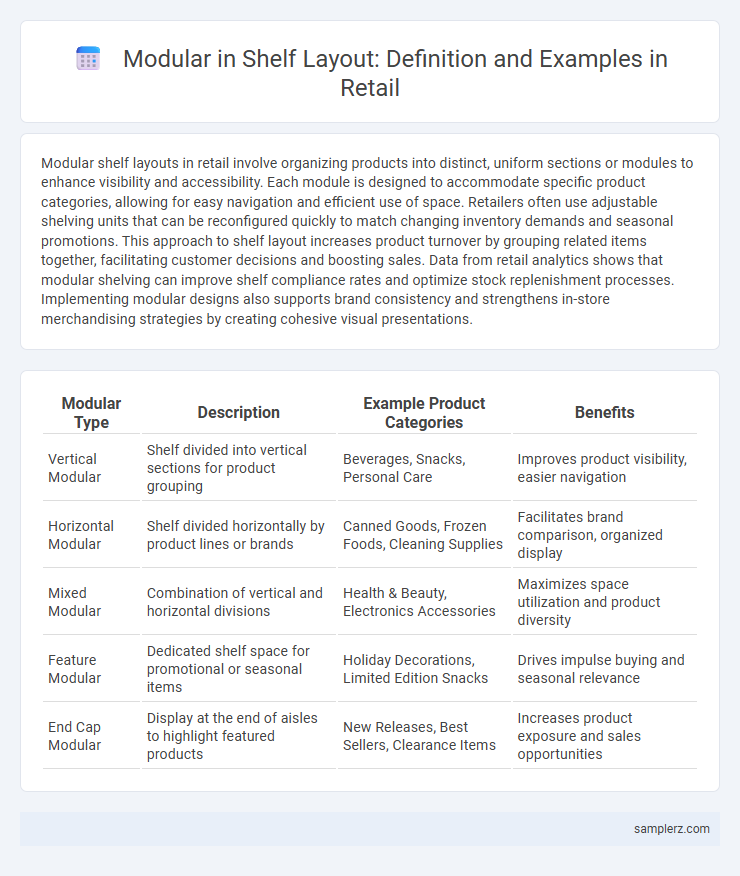Modular shelf layouts in retail involve organizing products into distinct, uniform sections or modules to enhance visibility and accessibility. Each module is designed to accommodate specific product categories, allowing for easy navigation and efficient use of space. Retailers often use adjustable shelving units that can be reconfigured quickly to match changing inventory demands and seasonal promotions. This approach to shelf layout increases product turnover by grouping related items together, facilitating customer decisions and boosting sales. Data from retail analytics shows that modular shelving can improve shelf compliance rates and optimize stock replenishment processes. Implementing modular designs also supports brand consistency and strengthens in-store merchandising strategies by creating cohesive visual presentations.
Table of Comparison
| Modular Type | Description | Example Product Categories | Benefits |
|---|---|---|---|
| Vertical Modular | Shelf divided into vertical sections for product grouping | Beverages, Snacks, Personal Care | Improves product visibility, easier navigation |
| Horizontal Modular | Shelf divided horizontally by product lines or brands | Canned Goods, Frozen Foods, Cleaning Supplies | Facilitates brand comparison, organized display |
| Mixed Modular | Combination of vertical and horizontal divisions | Health & Beauty, Electronics Accessories | Maximizes space utilization and product diversity |
| Feature Modular | Dedicated shelf space for promotional or seasonal items | Holiday Decorations, Limited Edition Snacks | Drives impulse buying and seasonal relevance |
| End Cap Modular | Display at the end of aisles to highlight featured products | New Releases, Best Sellers, Clearance Items | Increases product exposure and sales opportunities |
Introduction to Modular Shelf Layouts in Retail
Modular shelf layouts in retail consist of standardized, interchangeable units designed to optimize space, enhance product visibility, and improve customer navigation. Each module adapts to various product sizes and categories, facilitating easy reconfiguration and inventory management. This flexibility supports dynamic merchandising strategies and maximizes retail floor efficiency.
Benefits of Modular Designs for Retail Shelving
Modular designs for retail shelving offer enhanced flexibility, allowing retailers to easily reconfigure layouts to accommodate changing product assortments and seasonal promotions. This adaptability improves space utilization and customer flow, resulting in increased sales opportunities and a more engaging shopping experience. Durable materials and standardized components also reduce maintenance costs and simplify inventory management for retail operations.
Common Types of Modular Shelf Layouts
Common types of modular shelf layouts in retail include grid, free-flow, and loop configurations, each designed to optimize product visibility and customer flow. Grid layouts maximize space efficiency with rigid, linear shelving, ideal for supermarkets or convenience stores. Free-flow layouts create a more relaxed shopping environment using irregular, open shelving, while loop layouts guide customers through a predetermined path, increasing exposure to all product categories.
Modular Shelving for Maximizing Product Visibility
Modular shelving systems in retail optimize shelf layout by allowing flexible section adjustments tailored to product size and category, enhancing overall visibility. Implementing adjustable shelves and interchangeable components facilitates strategic product placement, increasing customer engagement and sales conversion rates. Retailers benefit from modular shelving's adaptability, which supports inventory rotation and seasonal merchandising without costly fixture replacements.
Flexible Merchandising with Modular Units
Flexible merchandising with modular units allows retailers to easily customize shelf layouts to accommodate changing product assortments and seasonal promotions. Modular shelving systems feature adjustable components such as shelves, dividers, and display racks that can be reconfigured quickly to optimize space utilization and enhance product visibility. This adaptability drives higher sales by improving customer navigation and showcasing merchandise effectively.
Case Study: Successful Modular Shelf Layouts in Retail
Case studies from leading retailers like IKEA demonstrate that modular shelf layouts increase space efficiency by up to 30%, enhancing product visibility and customer navigation. Walmart's implementation of adjustable shelving modules reduced restocking time by 25%, improving inventory management and boosting sales. Target's modular shelving design also facilitated rapid seasonal product swaps, driving a 15% increase in turnover for promotional items.
Integrating Technology with Modular Shelf Solutions
Modular shelf solutions in retail often incorporate digital price tags and interactive touchscreens to enhance shopper engagement and streamline inventory management. These technology-integrated shelves enable real-time updates and personalized promotions, improving the customer experience and operational efficiency. Retailers benefit from adaptable layouts that support quick reconfiguration based on data-driven insights and consumer behavior patterns.
Space Optimization Using Modular Shelf Systems
Modular shelf systems enhance space optimization by allowing retailers to customize shelf configurations to fit varying product sizes and store layouts, maximizing display area without overcrowding. Adjustable shelves and interchangeable components enable efficient use of vertical and horizontal space, increasing inventory capacity while maintaining accessibility and aesthetic appeal. Implementing modular designs reduces wasted space and facilitates quick reorganization to accommodate seasonal merchandise or promotional displays.
Customization Options for Modular Shelving
Modular shelving systems in retail offer extensive customization options, including adjustable shelf heights, interchangeable panels, and configurable display units to maximize space utilization and product visibility. Retailers can tailor layouts to specific merchandise needs, seasonal changes, or promotional events, enhancing customer engagement and operational efficiency. These customizable features support dynamic store environments and facilitate easy reconfiguration without major renovations.
Future Trends in Modular Retail Shelf Layouts
Future trends in modular retail shelf layouts emphasize flexibility and technology integration, enabling dynamic product arrangements that respond to consumer behavior data in real time. Smart shelves equipped with RFID sensors and digital price tags facilitate seamless inventory management and personalized promotions. Sustainable materials and customizable components support eco-friendly practices while enhancing the shopper's interactive experience.

example of modular in shelf layout Infographic
 samplerz.com
samplerz.com